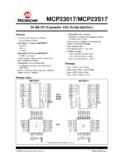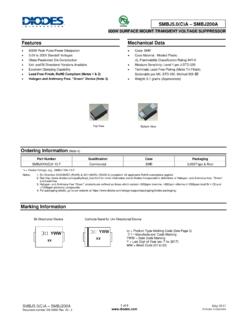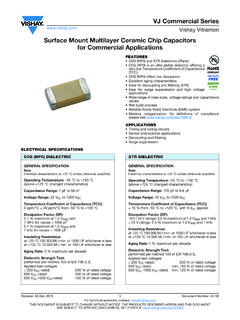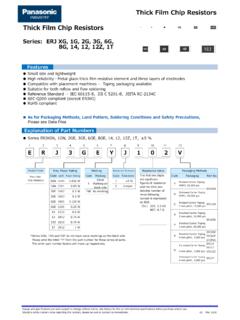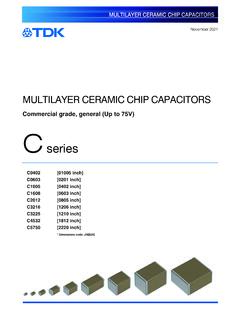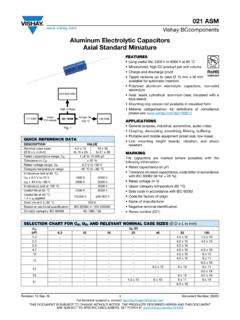Transcription of High Common-Mode Voltage, Difference Amplifier AD629
1 High Common-Mode Voltage, Difference Amplifier AD629 Rev. C Information furnished by Analog Devices is believed to be accurate and reliable. However, no responsibility is assumed by Analog Devices for its use, nor for any infringements of patents or other rights of third parties that may result from its use. Specifications subject to change without notice. No license is granted by implication or otherwise under any patent or patent rights of Analog Devices. Trademarks and registered trademarks are the property of their respective owners. One Technology Way, Box 9106, Norwood, MA 02062-9106, : Fax: 1999-2011 Analog Devices, Inc. All rights reserved. FEATURES Improved replacement for: INA117P and INA117KU 270 V Common-Mode voltage range Input protection to 500 V common mode 500 V differential mode Wide power supply range ( V to 18 V) 10 V output swing on 12 V supply 1 mA maximum power supply current HIGH ACCURACY DC PERFORMANCE 3 ppm maximum gain nonlinearity (AD629B) 20 V/ C maximum offset drift (AD629A) 10 V/ C maximum offset drift (AD629B) 10 ppm/ C maximum gain drift EXCELLENT AC SPECIFICATIONS 77 dB minimum CMRR @ 500 Hz (AD629A) 86 dB minimum CMRR @ 500 Hz (AD629B) 500 kHz bandwidth APPLICATIONS High voltage current sensing Battery cell voltage monitors Power supply current monitors Motor controls Isolation FUNCTIONAL BLOCK DIAGRAM 380k 380k 380k 20k REF( ) IN+IN VSNC+VSOUTPUTREF(+)AD629NC = NO CONNECT00783-001 Figure 1.
2 GENERAL DESCRIPTION The AD629 is a Difference Amplifier with a very high input, Common-Mode voltage range. It is a precision device that allows the user to accurately measure differential signals in the presence of high Common-Mode voltages up to 270 V. The AD629 can replace costly isolation amplifiers in applications that do not require galvanic isolation. The device operates over a 270 V Common-Mode voltage range and has inputs that are protected from Common-Mode or differential mode transients up to 500 V. The AD629 has low offset, low offset drift, low gain error drift, low Common-Mode rejection drift, and excellent CMRR over a wide frequency range. The AD629 is available in die and packaged form featuring 8-lead PDIP and 8-lead SOIC packages. For all packages (including die) and grades, performance is guaranteed over the industrial temperature range of 40 C to +85 C. FREQUENCY (Hz) Common-Mode REJECTION RATIO (dB)10050556065707580859095201001k10k20k 00783-002 Figure 2.
3 Common-Mode Rejection Ratio vs. Frequency Common-Mode VOLTAGE (V)OUTPUT ERROR (2mV/DIV) 240240120 120000783-0032mV/DIV60V/DIV Figure 3. Error Voltage vs. Input Common-Mode Voltage AD629 Rev. C | Page 2 of 16 TABLE OF CONTENTS Features .. 1 1 Functional Block Diagram .. 1 General Description .. 1 Revision History .. 2 3 Absolute Maximum 4 ESD 4 Pin Configuration and Function 5 Typical Performance Characteristics .. 6 Theory of Operation .. 10 11 Basic Connections .. 11 Single-Supply Operation .. 11 System-Level Decoupling and 11 Using a Large Sense 12 Output 12 Output Current and 13 A Gain of 19 Differential 13 Error Budget Analysis Example 1 .. 13 Error Budget Analysis Example 2 .. 14 Outline Dimensions .. 15 Ordering Guide .. 16 REVISION HISTORY 4/11 Rev. B to Rev. C Changes to General Description Section .. 1 Added Endnote 1 in Table 1 .. 3 Added Figure 5; Renumbered Sequentially .. 4 Added Table 3; Renumbered Sequentially.
4 4 Added Pin Configuration and Function Descriptions Section, Figure 6, and Table 4 .. 5 Changes to Ordering Guide .. 16 3/07 Rev. A to Rev. B Updated Format and Layout .. Universal Changes to Ordering Guide .. 15 3/00 Rev. 0 to Rev. A 10/99 Revision 0: Initial Version AD629 Rev. C | Page 3 of 16 SPECIFICATIONS TA = 25 C, VS = 15 V, unless otherwise noted. Table 1. AD629A1 AD629B Parameter Condition Min Typ Max Min Typ Max Unit GAIN VOUT = 10 V, RL = 2 k Nominal Gain 1 1 V/V Gain Error % Gain Nonlinearity 4 10 4 10 ppm RL = 10 k 1 1 3 ppm Gain vs. Temperature TA = TMIN to TMAX 3 10 3 10 ppm/ C OFFSET VOLTAGE Offset Voltage 1 mV VS = 5 V 1 mV vs.
5 Temperature TA = TMIN to TMAX 6 20 3 10 V/ C vs. Supply (PSRR) VS = 5 V to 15 V 84 100 90 110 dB INPUT Common-Mode Rejection Ratio VCM = 250 V dc 77 88 86 96 dB TA = TMIN to TMAX 73 82 dB VCM = 500 V p-p, dc to 500 Hz 77 86 dB VCM = 500 V p-p, dc to 1 kHz 88 90 dB Operating Voltage Range Common mode 270 270 V Differential 13 13 V Input Operating Impedance Common mode 200 200 k Differential 800 800 k OUTPUT Operating Voltage Range RL = 10 k 13 13 V RL = 2 k V VS = 12 V.
6 RL = 2 k 10 10 V Output Short-Circuit Current 25 25 mA Capacitive Load Stable operation 1000 1000 pF DYNAMIC RESPONSE Small Signal 3 dB Bandwidth 500 500 kHz Slew Rate V/ s Full Power Bandwidth VOUT = 20 V p-p 28 28 kHz Settling Time , VOUT = 10 V step 15 15 s , VOUT = 10 V step 12 12 s , VCM = 10 V step, VDIFF = 0 V 5 5 s OUTPUT NOISE VOLTAGE Hz to 10 Hz 15 15 V p-p Spectral Density.
7 100 Hz2 550 550 nV/ Hz POWER SUPPLY Operating Voltage Range 18 18 V Quiescent Current VOUT = 0 V 1 1 mA TMIN to TMAX mA TEMPERATURE RANGE For Specified Performance TA = TMIN to TMAX 40 +85 40 +85 C 1 Specifications for the AD629 A grade are also valid for the die model (listed in the as AD629AC-WP).
8 Ordering Guide 2 See . Figure 21 AD629 Rev. C | Page 4 of 16 ABSOLUTE MAXIMUM RATINGS Table 2. Parameter Rating Supply Voltage, VS 18 V Internal Power Dissipation1 8-Lead PDIP (N) See Figure 4 8-Lead SOIC (R) See Figure 4 Input Voltage Range, Continuous 300 V Common-Mode and Differential, 10 sec 500 V Output Short-Circuit Duration Indefinite Pin 1 and Pin 5 VS V to +VS + V Maximum Junction Temperature 150 C Operating Temperature Range 55 C to +125 C Storage Temperature Range 65 C to +150 C Lead Temperature (Soldering 60 sec) 300 C 1 Specification is for device in free air: 8-Lead PDIP, JA = 100 C/W; 8-Lead SOIC, JA = 155 C/W. Stresses above those listed under Absolute Maximum Ratings may cause permanent damage to the device.
9 This is a stress rating only; functional operation of the device at these or any other conditions above those indicated in the operational section of this specification is not implied. Exposure to absolute maximum rating conditions for extended periods may affect device reliability. AMBIENT TEMPERATURE ( C)MAXIMUM POWER DISSIPATION (W) 50 40 30 20 10 010 20 30 40 50 60 70 80 9000783-0048-LEAD SOICTJ = 150 C8-LEAD PDIP Figure 4. Maximum Power Dissipation vs. Temperature for SOIC and PDIP DIE SIZE: 1655 m (X) by 2465 m (Y)XY721a1b345a5b6b6a00783-041 Figure 5. Metallization Photograph Table 3. Pin Pad Coordinates Coordinates1 Pad Pin X Y Description 1a REF( ) 677 +1082 1b 534 +1084 For the die model, either pad can be bonded because 1a and 1b are internally shorted. 2 IN 661 +939 3 +IN 661 658 4 VS +680 800 5a REF(+) +396 1084 5b +538 1084 For the die model, either pad can be bonded because 5a and 5b are internally shorted.
10 6a OUTPUT +681 950 6b +681 807 For the die model, both pads must be bonded because 6a and 6b are not internally shorted. 7 +VS +680 +612 1 All coordinates are with respect to the center of the die. ESD CAUTION AD629 Rev. C | Page 5 of 16 PIN CONFIGURATION AND FUNCTION DESCRIPTIONS REF( )1 IN2+IN3 VS4NC8+VS7 OUTPUT6 REF(+)5NC = NO CONNECTAD629 TOP VIEW(Not to Scale)00783-040 Figure 6. Pin Configuration Table 4. Pin Function Descriptions Pin No. Mnemonic Description 1 REF( ) Negative Reference Voltage Input. 2 IN Inverting Input. 3 +IN Noninverting Input. 4 VS Negative Supply Voltage. 5 REF(+) Positive Reference Voltage Input. 6 OUTPUT Output.










